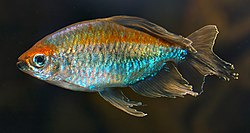| Phenacogrammus | |
|---|---|
 | |
| Phenacogrammus interruptus | |
| Scientific classification | |
| Domain: | Eukaryota |
| Kingdom: | Animalia |
| Phylum: | Chordata |
| Class: | Actinopterygii |
| Order: | Characiformes |
| Family: | Alestidae |
| Genus: | Phenacogrammus C. H. Eigenmann, 1907 [1] |
| Type species | |
| Micralestes interruptus | |
Phenacogrammus is a genus of freshwater ray-finned fishes belonging to the family Alestidae, the African tetras. These fishes are found in Western and Central Africa.